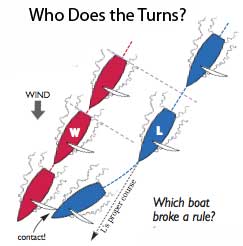A brain teaser from David Dellenbaugh’s Speed & Smarts, subscriptions available here. Reprinted by permissions.

On the first reach of a recent one-design race, a leeward boat (L) came from astern and established a leeward overlap close to a windward boat (W). Shortly afterward L began to head up until she was sailing about 30° above her proper course. She then had contact with the end of W’s boom. W, who had been sailing a straight (and proper) course the whole time, filed a protest. As a juror, what action would you recommend at the protest hearing?
A) Don’t penalize either boat
B) Penalize both boats
C) Penalize W
D) Penalize L
The correct answer is B) Penalize both boats. The leeward boat (L) got a leeward overlap from behind within 2 lengths of the windward boat (W). So according to rule 17, L wasn’t permitted to sail above a proper course (while they remained on the same tack and overlapped within that distance). Since L sailed above her proper course, she broke rule 17 and should be penalized.
While the boats are overlapped, W is a windward boat so she must keep clear of L in accordance with rule 11 (On the Same Tack; Overlapped). Since W didn’t keep clear here, she broke rule 11 and should be penalized unless there is a reason to exonerate her. Rule 64.1 says, “When as a consequence of breaking a rule a boat has compelled another boat to break a rule . . . [the other boat] shall be exonerated.” L did break rule 17 but she did not compel W to break rule 11. Since L luffed slowly, W could have kept clear by heading up. Therefore, W should be penalized for breaking rule 11